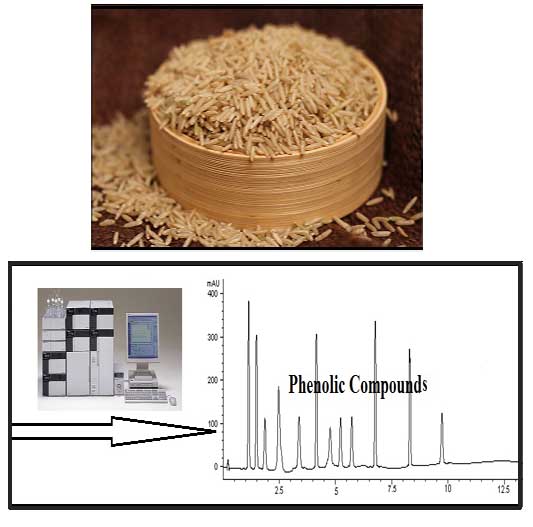[1] J. Vichapong, M. Sookserm, V. Srijesdaruk, P. Swatsitang and S. Srijaranai, High performance liquid chromatographic analysis of phenolic compounds and their antioxidant activities in rice varieties. LWT-Food Science and Technology, 43 (2010) 1325-1330.
[2] S. Tian, K. Nakamura and H. Kayahara, Analysis of phenolic compounds in white rice, brown rice, and germinated brown rice. Journal of agricultural and food chemistry, 52 (2004) 4808-4813.
[3] S. Ragaee, K. Seetharaman and E.-S.M. Abdel-Aal, The impact of milling and thermal processing on phenolic compounds in cereal grains. Critical reviews in food science and nutrition, 54 (2014) 837-849.
[4] P. Gélinas and C.M. McKinnon, Effect of wheat variety, farming site, and bread‐baking on total phenolics. International journal of food science & technology, 41 (2006) 329-332.
[5] L. Yu and K. Zhou, Antioxidant properties of bran extracts fromPlatte'wheat grown at different locations. Food Chemistry, 90 (2005) 311-316.
[6] N. Balasundram, K. Sundram and S. Samman, Phenolic compounds in plants and agri-industrial by-products: Antioxidant activity, occurrence, and potential uses. Food chemistry, 99 (2006) 191-203.
[7] D. De Beer, E. Joubert, W. Gelderblom and M. Manley, Phenolic compounds: a review of their possible role as in vivo antioxidants of wine. South African Journal of Enology and Viticulture, 23 (2002) 48-61.
[8] M. Naczk and F. Shahidi, Extraction and analysis of phenolics in food. Journal of chromatography A, 1054 (2004) 95-111.
[9] R.H. Liu, Whole grain phytochemicals and health. Journal of Cereal Science, 46 (2007) 207-219.
[10] J. Sánchez-Rangel, J. Benabides and D. Jacabo-Velázquez, Abiotic stress based bioprocesses for the production of high value antioxidant phenolic compound in plants: an overview. Revista Mexicana de Ingeniería Química, 13 (2014) 49-61.
[11] T. de Brum, M. Zadra, M. Piana, A. Boligon, J. Fröhlich, R. de Freitas, S. Stefanello, A. Froeder, B. Belke and L. Nunes, HPLC analysis of phenolics compounds and antioxidant capacity of leaves of Vitex megapotamica (Sprengel) Moldenke. Molecules, 18 (2013) 8342-8357.
[12] R. Puupponen‐Pimiä, L. Nohynek, C. Meier, M. Kähkönen, M. Heinonen, A. Hopia and K.M. Oksman‐Caldentey, Antimicrobial properties of phenolic compounds from berries. Journal of applied microbiology, 90 (2001) 494-507.
[13] M.J. Rhodes and K. Price, Identification and analysis of plant phenolic antioxidants. European journal of cancer prevention: the official journal of the European Cancer Prevention Organisation (ECP), 6 (1997) 518-521.
[14] V. Cheynier, Phenolic compounds: from plants to foods. Phytochemistry Reviews, 11 (2012) 153-177.
[15] R. Niggeweg, A.J. Michael and C. Martin, Engineering plants with increased levels of the antioxidant chlorogenic acid. Nature biotechnology, 22 (2004) 746.
[16] R.E. Anli, N. Vural and E. Kizilet, An alternative method for the determination of some of the antioxidant phenolics in varietal turkish red wines. Journal of the Institute of Brewing, 114 (2008) 239-245.
[17] M. Hawrył, A. Hawrył and E. Soczewiński, Application of normal-and reversed-phase 2D TLC on a cyanopropyl-bonded polar stationary phase for separation of phenolic compounds from the flowers of Sambucus nigra L. JPC-Journal of Planar Chromatography-Modern TLC, 15 (2002) 4-10.
[18] F. Kvasnička, J. Čopíková, R. Ševčík, J. Krátká, A. Syntytsia and M. Voldřich, Determination of phenolic acids by capillary zone electrophoresis and HPLC. Open Chemistry, 6 (2008) 410-418.
[19] S. Martins, S.I. Mussatto, G. Martínez-Avila, J. Montañez-Saenz, C.N. Aguilar and J.A. Teixeira, Bioactive phenolic compounds: production and extraction by solid-state fermentation. A review. Biotechnology advances, 29 (2011) 365-373.
[20] A. Hayat, T.M. Jahangir, M.Y. Khuhawar, M. Alamgir, Z. Hussain, F.U. Haq and S.G. Musharraf, HPLC determination of gamma amino butyric acid (GABA) and some biogenic amines (BAs) in controlled, germinated, and fermented brown rice by pre-column derivatization. Journal of cereal science, 64 (2015) 56-62.
[21] A. Hayat, T.M. Jahangir, M.Y. Khuhawar, M. Alamgir, A.J. Siddiqui and S.G. Musharraf, Simultaneous HPLC determination of gamma amino butyric acid (GABA) and lysine in selected Pakistani rice varieties by pre-column derivatization with 2-Hydroxynaphthaldehyde. Journal of cereal science, 60 (2014) 356-360.
[22] S. Inagaki, T. Kato, S. Mori and T. Fujita, Composition and Antioxidant Activity of Rice Fermented with Saccharifying Organisms from Asian Countries. Food Science and Technology Research, 19 (2013) 893-899.
[23] M. Pinelo, B. Zornoza and A.S. Meyer, Selective release of phenols from apple skin: Mass transfer kinetics during solvent and enzyme-assisted extraction. Separation and Purification Technology, 63 (2008) 620-627.
[24] Y. Shao, F. Xu, X. Sun, J. Bao and T. Beta, Identification and quantification of phenolic acids and anthocyanins as antioxidants in bran, embryo and endosperm of white, red and black rice kernels (Oryza sativa L.). Journal of cereal science, 59 (2014) 211-218.


